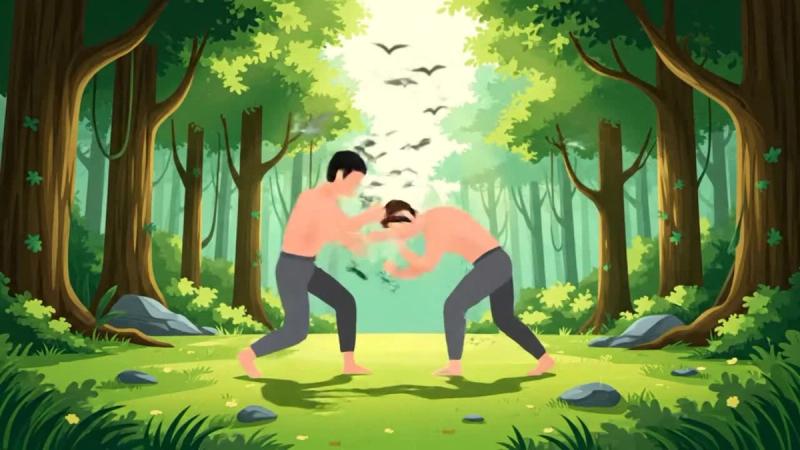Introduction
If you follow B-Team (now Simple Man Martial Arts) on YouTube or watch CJI, you’ve probably heard the word “ecological.” It’s easy to assume this means “eco-friendly,” but that’s not it. In sport science and coaching, ecological refers to training and coaching principles grounded in the ecological approach/ecological dynamics.
Put simply, instead of memorising a fixed sequence and drilling it in isolation, you design game-like environments and constraints, then let athletes find functional movement solutions by repeating those situations. In grappling, Greg Souders (Standard Jiu-Jitsu), known for coaching athletes like DeAndre Corbe, has been a leading voice. Some view his stance as extreme, which draws criticism; this article introduces his ideas but takes a broader, more flexible view of ecological training for grappling.
What “Ecological Training” Means
Core idea
Ecological training starts from the view that there is no single “perfect” form. That doesn’t mean “anything goes.” It means the optimal movement for, say, a knee cut depends on many conditions—your opponent’s size, strength, and reactions; your own fatigue, attributes, and timing; even boundary effects near the edge of the mat. Because conditions vary, the best solution also varies.
What does that imply for drilling?
If real exchanges never replicate exactly, then repeating the identical move in the exact setup is limited. Ecological training still values repetition, but the repetition focuses on the goal (e.g., pass the knee line), while the conditions vary (opponent reactions, entries, angles, time pressure). In practice, this looks like small-sided, situation sparring rather than rote choreography.
Why constraint design matters
If your goal is broadly “improve passing,” setting “always do a knee cut” is too narrow; setting “start from neutral and try to pass” is too wide (it becomes regular sparring). The art is matching the constraint to the objective: tighten the focus when the intent is vague; loosen it if creativity is getting stifled.
More broadly, ecological training suggests that skill practice should occur within the competitive context as much as possible. This idea isn’t brand new in sport psychology, but it’s been spotlighted lately by Rob Gray (PhD, author of books and podcasts).
Souders often explains that he arrived here by questioning the “do 10,000 repetitions” dogma. At Standard Jiu-Jitsu, he claims to avoid traditional technique demo + rote drilling altogether, even for beginners, and instead teaches entirely through task-designed games. Whether you see that as too extreme or not, it’s consistent with the ecological stance: if the goal is achieved, the movement was “right,” and robust movement emerges from live interaction.
Example Setups (game design ideas)
- Souders’ Games
Curated at: https://www.playjiujitsugames.com/ - Priit Mihkelson seminars
Focus on transitions and edges of positions rather than static holds:
“Front headlock → take the back / don’t allow the back,”
“From turtle, take an arm / don’t allow the arm,”
“Turn turtle over / prevent the turnover.”
Bringing It Into Daily Practice
- Technique learning = understand the logic → test under varied conditions
Define the objective (e.g., clear the knee line, pin the shoulders), then convert it into short, focused situation rounds. - Perception–action loop
Watch (observe cues) → Immediately do constrained live rounds. Consider dedicating a few rounds to observation only to sharpen perception. - Especially powerful for defence
Most classes drill from fixed checkpoints (“hooks in or not,” “grip A or B”). But matches are decided in the in-between—the moment before the back is fully taken, the instant the underhook appears, the edge scramble. Tight, repeatable constraints shine in these fluid phases.
Snapshots from Other Sports
- NBA / MLB
Recent coverage discussed Victor Wembanyama and Shohei Ohtani within constraint-oriented training contexts:
https://www.nytimes.com/athletic/6665943/2025/09/29/sports-training-cla-coaching-wembanyana-ohtani/
- Football (soccer)
FIFA’s Training Centre highlights ecological dynamics—vary pitch size, numbers, and rules to shape decision-making:
https://www.fifatrainingcentre.com/en/environment/science-explained/high-performance/train/keith-davids-on-ecological-dynamics.php
- Wrestling
In my experience, many “drills” are already implicitly ecological: the receiver moves and reacts while the attacker executes, rather than staying slack and passive.
Theory & Keywords (one-liners)
- Affordances (Gibson, 1979):
The environment offers possibilities for action; athletes pick up those invitations directly. - Ecological Dynamics:
Ecological psychology × dynamical systems. Self-organisation and constraints shape skill. - Constraints-Led Approach (CLA):
Coach = environment designer. Adjust individual / task / environmental constraints (rules, start states, equipment, numbers, time pressure) to invite the behaviour you want. - Perception–Action Coupling:
Perception and movement are inseparable; as the information changes, so does the action.
Further Reading
- BJJ-specific
Greg Souders long-form interviews/lectures (YouTube, podcasts)
Play Jiujitsu Games — game templates: https://www.playjiujitsugames.com/ - Coaches/practitioners
Rob Gray — How We Learn to Move (2021) and Perception & Action Podcast
Keith Davids, Ian Renshaw, et al. — The Constraints-Led Approach (2019) - Foundations
J. J. Gibson — The Ecological Approach to Visual Perception (1979)
Reviews on ecological dynamics in sport (Davids, Araújo, et al.)
Closing
In BJJ, winning isn’t about memorising a perfect form—it’s about reading what the situation affords right now (opponent, space, time, friction) and acting decisively. The ecological approach provides coaches and athletes with a practical way to design the practice environment, allowing ability to emerge under live pressure. Start small: adopt one or two tight situation games, then tune the constraints to your context.




